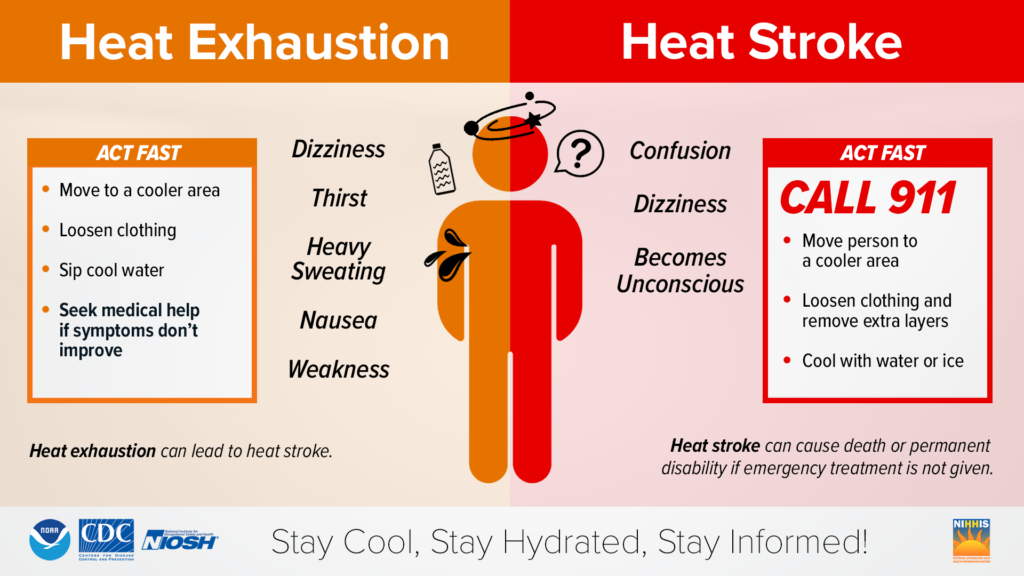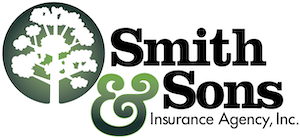Train your employees to recognize the risk and symptoms

Heat Cramps, Heat Exhaustion and Heat Stroke – 3 levels of one serious summer problem – IT IS HOT IN OKLAHOMA!
The National Weather Service shared the above graphic, to go along with the CDC’s warning signs and symptoms of heat illness, and the recommended first aid steps (below). From the NWS article: “
Heat Cramps
Heat cramps may be the first sign of heat-related illness, and may lead to heat exhaustion or stroke.
- Symptoms: Painful muscle cramps and spasms usually in legs and abdomen and Heavy sweating.
- First Aid: Apply firm pressure on cramping muscles or gently massage to relieve spasm. Give sips of water unless the person complains of nausea, then stop giving water.
Seek immediate medical attention if cramps last longer than 1 hour.
Heat Exhaustion
- Symptoms: Heavy sweating, Weakness or tiredness, cool, pale, clammy skin; fast, weak pulse, muscle cramps, dizziness, nausea or vomiting, headache, fainting,
- First Aid: Move person to a cooler environment, preferably a well air conditioned room. Loosen clothing. Apply cool, wet cloths or have person sit in a cool bath. Offer sips of water. If person vomits more than once,
Seek immediate medical attention if the person vomits, symptoms worsen or last longer than 1 hour
Heat Stroke
- Symptoms: Throbbing headache, confusion, nausea, dizziness, body temperature above 103°F, hot, red, dry or damp skin, rapid and strong pulse, fainting, loss of consciousness.
- First Aid: Call 911 or get the victim to a hospital immediately. Heat stroke is a severe medical emergency. Delay can be fatal. Move the victim to a cooler, preferably air-conditioned, environment. Reduce body temperature with cool cloths or bath. Use fan if heat index temperatures are below the high 90s. A fan can make you hotter at higher temperatures. Do NOT give fluids.
Using a fan to blow air in someone’s direction may actually make them hotter if heat index temperatures are above the 90s. For more information on all of these heat related illnesses, see the Centers for Disease Control and Prevention (CDC) site.”

These signs are easy to miss or ignore. Your employees and coworkers (an you, too!) should constantly be checking on one another for any of these signs. Encourage or even mandate frequent water breaks for anyone working outside or in hot indoor environments. Re-emphasize the “WATER” part of “water break”, as some employees may take to their preferred soft drink.
Safety precautions and emergency response processes must be a regular part of employee training. As the seasons change, the risks involved also change. For those employees who will be exposed to the brutally hot sun in Oklahoma, heat related illnesses and prevention, warning signs, instructions on how to handle a situation, and incident reporting should all be a part of the daily job safety analysis.
While overtraining and over-emphasizing these topics may feel like a waste of time, it also may be the difference between no heat related incidents all season and an overnight hospital stay for one or more of your valued employees.
Our own agent, Ryan Smith, has a little experience with these symptoms.
“One of my summer-time jobs in college was mowing lawns with an experienced crew. One morning in 2010 I applied to an online job ad for lawn care and landscaping. Not really expecting to get a call back immediately, I made myself lunch – regrettably, an egg salad sandwich with a soda – and didn’t think much about it. Almost right away, I got a phone call from this employer, asking me to meet them across town and ride with them to the next customer’s site to help mow. Mid-summer heat, starting off right after lunch, not being hydrated going into it – it was a recipe for disaster. These guys were good. It was relatively quiet in the truck as everyone was enjoying the air conditioning, finishing off their lunch. But as soon as we got to the job site, it was all systems “GO!”. Even though I have been mowing lawns since I was a young kid, I wasn’t ready for this type of operation. From one site to the next for 5 hours, I was dealing with cramps, heavy sweating, stomach aches and light-headedness. Somehow I made it to the very end of the day before I got sick into a dumpster full of grass clippings. Working so hard in such trying conditions demands preparation and days of hydrating to be able to keep up with the hard-working men I was paired with that day.”
In many cases, there is a point of pride that must be considered, too. The people that work day-in and day-out in these positions have to be tough. Unfortunately, this sometimes leads to them ignoring warning signs of being too hot. There is also a time constraint to consider. A coworker may feel compelled to push through the light-headedness so that they don’t slow down others on the job.
Whatever the situation, the solution comes from preparation. Build out a company culture where employees are supporting each-other, not demanding over-exertion of one another.
